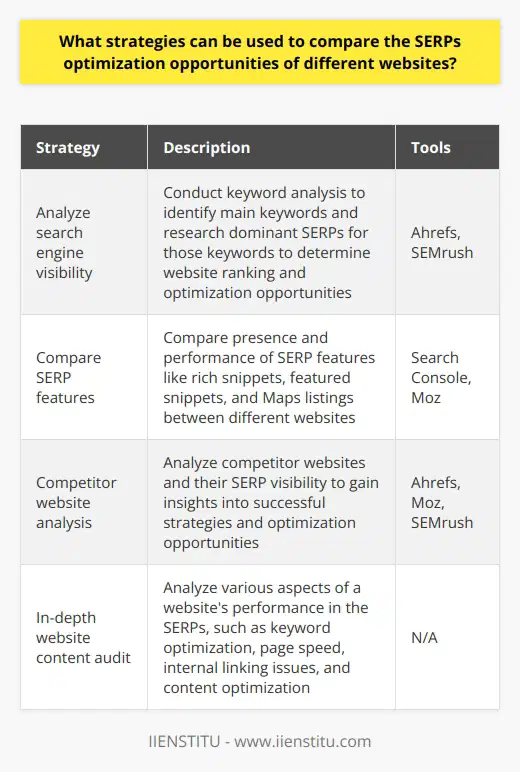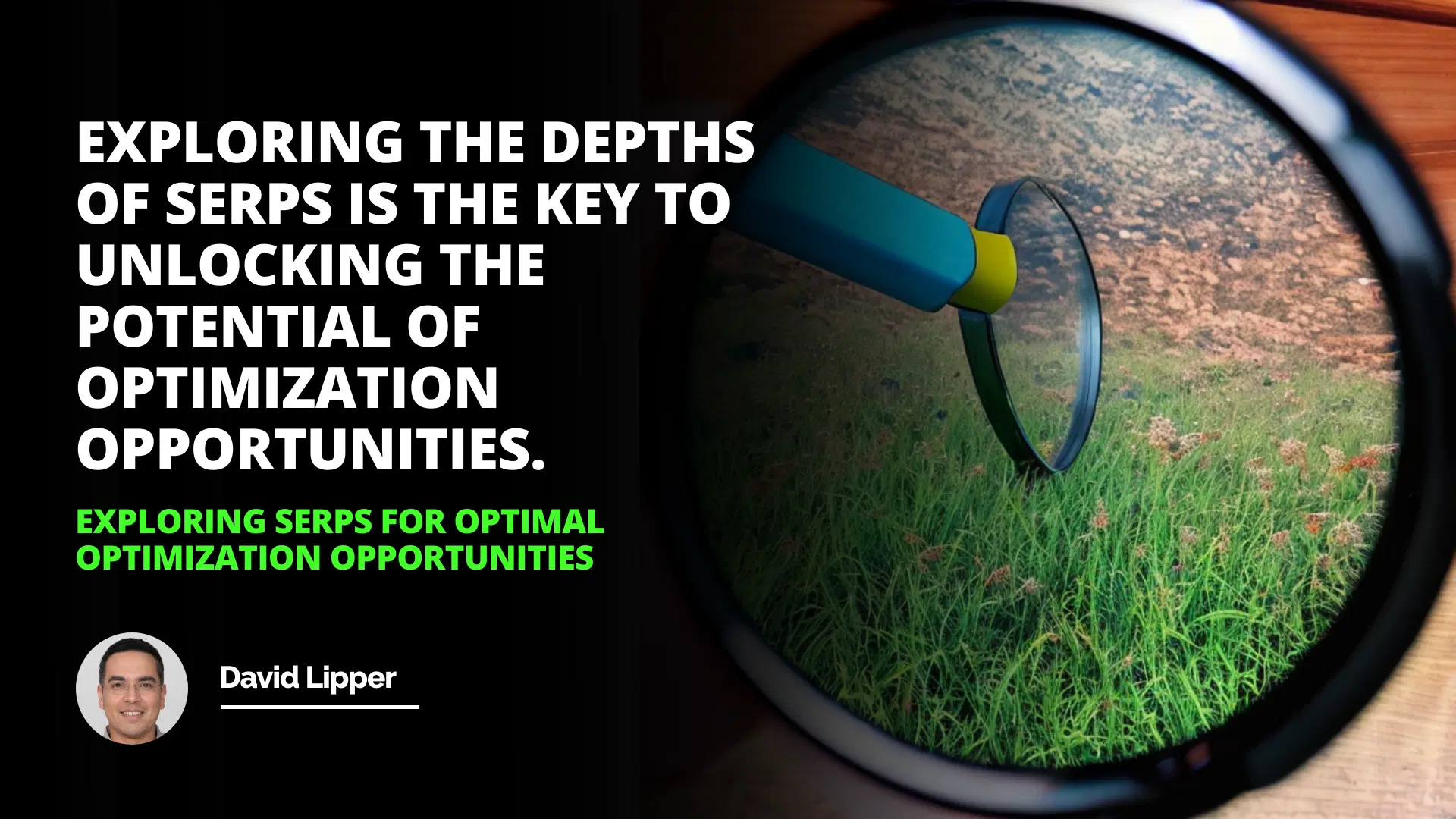
Understanding SERPs: A Journey into Search Engine Optimization
Overview of SERPs
Optimally Optimizing SERPs
Strategies for Implementing SERPs Optimization
Remember the first time you typed a query into a search engine and were amazed by the instant answers? I still recall searching for "best hiking trails near me" and being overwhelmed by the wealth of information that appeared. This experience is thanks to Search Engine Results Pages (SERPs), a fundamental aspect of how we interact with the internet today.
In this discussion, we'll dive deep into the world of SERPs, exploring their components, advantages, and strategies to optimize them effectively. Whether you're a business owner, a budding blogger, or just curious, understanding SERPs is crucial in navigating the digital landscape.
The Essence of SERPs
At their core, SERPs are the pages displayed by search engines in response to a user's query. They are not just simple lists of website links; they are dynamic, informative pages designed to provide the most relevant information quickly and efficiently.
Components of SERPs
A typical SERP includes various elements:
1- Organic Search Results: Listings that appear due to their relevance to the search terms.
2- Paid Advertisements: Sponsored results, usually labeled as "Ad."
3- Featured Snippets: Highlighted boxes providing direct answers.
4- Knowledge Panels: Information boxes about entities like businesses or individuals.
5- Image and Video Results: Multimedia content relevant to the query.
6- Local Results and Maps: Geographically tailored results.
Advantages of SERPs
Quick Access to Information: Users receive immediate answers without digging through multiple sites.
Diverse Content Formats: From text to videos and images, catering to different preferences.
Personalized Results: Based on location, search history, and preferences.
Disadvantages of SERPs
Information Overload: The abundance of information can be overwhelming.
Potential Bias: Algorithms might favor certain sites, limiting exposure to diverse viewpoints.
Outdated Content: Not all top results are updated regularly, which can mislead users.
My Personal Encounter with SERP Challenges
I once helped a friend launch an online store. Despite having a fantastic product line, her website wasn't getting any traffic. It was buried deep in the search results, practically invisible. This led me to explore the intricacies of search engine optimization (SEO) and how to leverage SERPs for better visibility.
Optimally Optimizing SERPs
Understanding how to optimize your website for SERPs is essential. It's not just about appearing in search results but about being in the right place at the right time. Here's how you can achieve that:
1. Keyword Research is Key
Identifying the terms your target audience uses is the foundation. For instance, if you're in the logistics industry, a long-tail keyword like optimize supply chain management process tips can attract a niche audience.
Tools to use:
Google's Keyword Planner
SEMrush
Ahrefs
2. Quality Content Creation
Content is still king. Ensure your content is:
Relevant: Addresses the needs and queries of your audience.
Engaging: Uses storytelling, visuals, and interactive elements.
Updated Regularly: Keeps information current and accurate.
Optimizing keywords
Providing an optimal user experience
Optimizing site performance
Paying attention to mobile traffic
3. On-Page SEO Techniques
Optimize individual pages to rank higher:
Title Tags and Meta Descriptions: Include primary keywords.
Header Tags (H2, H3, H4, etc.): Organize content logically.
Internal Linking: Connect related content within your site.
4. Technical SEO
Enhance the backend of your site:
Site Speed: Ensure quick loading times.
Mobile Responsiveness: Cater to users on all devices.
Secure Protocol (HTTPS): Build trust with your audience.
Demystifying SEO: What It Means and Why It Matters
You might be wondering, "SEO meaning?" Simply put, Search Engine Optimization (SEO) is the practice of increasing the quantity and quality of traffic to your website through organic search engine results.
SEO definition: The art and science of persuading search engines to recommend your content to users.
SEO what is SEO: It's about understanding what people are searching for and providing them with the best possible answers.
The Significance of Search Engine Optimization
Search engine optimization means positioning your website to appear prominently when potential customers search for products or services you offer.
Embracing SEO Services
For many businesses, handling SEO in-house can be overwhelming. This is where SEO services come into play. They offer:
Exploring the depths of SERPs is the key to unlocking the potential of optimization opportunities.
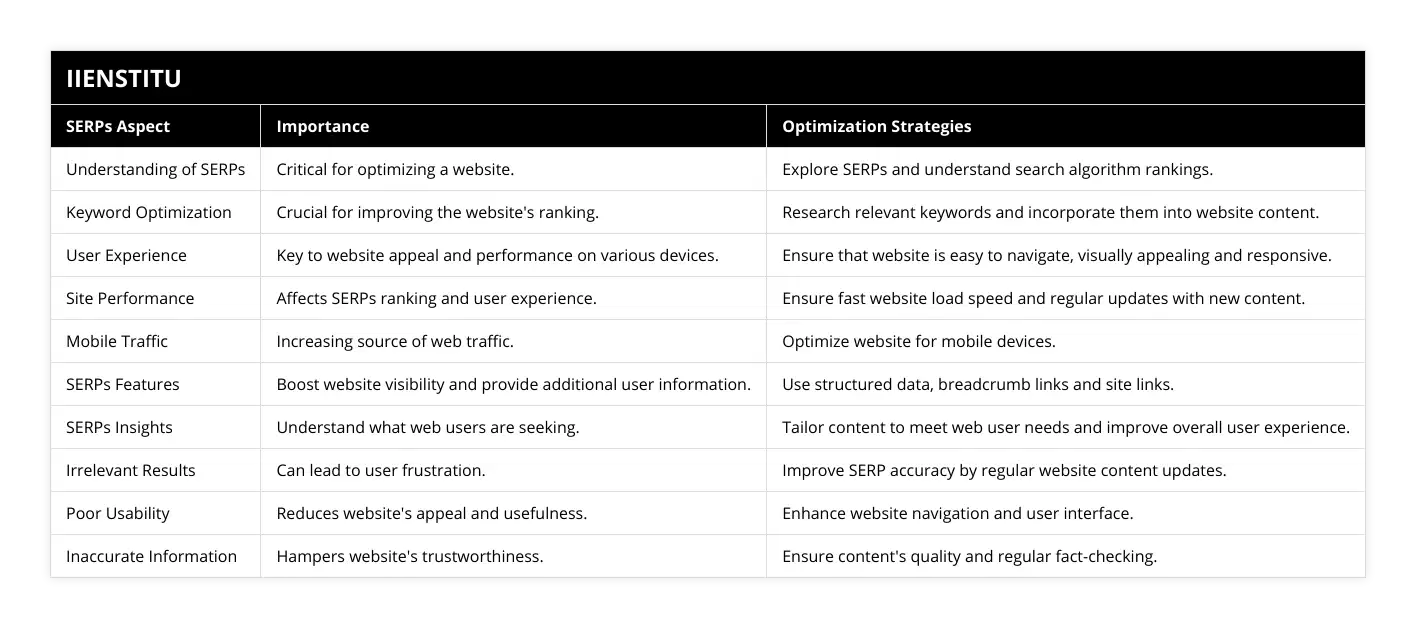
Expertise: Knowledge of the latest SEO trends and algorithms.
Time Savings: Allowing you to focus on core business activities.
Measurable Results: Through analytics and regular reporting.
Enhancing Visibility Through Search Optimization
Search optimization isn't just about keywords. It's about:
Understanding User Intent: What users are truly seeking.
Creating High-Quality Backlinks: From reputable sites.
Optimizing User Experience: Easy navigation, clear calls to action.
The Role of Search Engine Marketing
While SEO search engine focuses on organic traffic, search engine marketing (SEM) involves paid strategies to increase visibility.
Combining SEO and SEM: Maximizes reach and effectiveness.
Using Tools Like Google Ads: To target specific keywords and demographics.
Strategies for Implementing SERP Optimization
Implementing effective SERP optimization involves a holistic approach:
1- Understand Your Audience
Conduct market research.
Create buyer personas.
2- Optimize for Mobile Traffic
Use responsive design.
Simplify navigation for smaller screens.
3- Enhance Site Performance
Compress images.
Minimize HTTP requests.
4- Leverage Social Media
Share content across platforms.
Encourage social sharing.
5- Monitor and Analyze
Use tools like Google Analytics.
Adjust strategies based on data.
The Importance of User Experience
An optimal user experience (UX) keeps visitors engaged:
Intuitive Design: Users find what they need effortlessly.
Fast Loading Pages: Reduces bounce rates.
Accessible Content: Cater to users with disabilities.
Underlining Key Concepts
Ensuring that certain elements stand out is crucial:
Bold Text: Highlights important points.
Italicized Text: Emphasizes key terms.
Underlined Text: Draws attention to critical information.
Common Mistakes to Avoid
Ignoring SEO Basics: Skipping title tags and meta descriptions.
Keyword Stuffing: Overusing keywords can lead to penalties.
Neglecting Content Quality: Focusing solely on SEO at the expense of value.
A Glimpse into the Future
The digital landscape is ever-evolving:
Voice Search: Optimizing for conversational queries.
Artificial Intelligence: Personalized search results.
Visual Search: Using images to search for information.
Conclusion
Navigating the complexities of search engine optimization and SERPs can seem daunting, but with the right strategies, it's entirely achievable. By focusing on delivering value, understanding your audience, and staying updated on the latest trends, you can significantly enhance your online visibility.
References
Enge, E., Spencer, S., & Stricchiola, J. (2015). The Art of SEO. O'Reilly Media.
Kent, P. (2019). Search Engine Optimization For Dummies. John Wiley & Sons.
Clarke, A. (2023). SEO 2023: Learn Search Engine Optimization. Internet Marketing.
Key Takeaways:
SERPs are critical in how users find information online.
Optimizing for search engines enhances your visibility and credibility.
Avoid common pitfalls like neglecting content quality and overusing keywords.
Stay informed about emerging trends like voice and visual search.
Consider professional SEO services for expert guidance.
By embracing these insights and dedicating effort to continuous improvement, you'll be well on your way to mastering search engine optimization and leveraging search engine results pages to your advantage.
Frequently Asked Questions
What metrics are used to determine the optimal optimization opportunities when exploring SERPs?
Search Engine Result Pages (SERPs) are the search results pages that most search engines display in response to a user's search query. Optimizing SERPs is essential for getting the most visibility, gaining clicks, and driving website traffic. However, to optimize SERPs effectively, it is necessary to understand the metrics used to measure their success.
First, it is essential to consider the click-through rate (CTR). CTR is a metric that measures the percentage of searchers who click on the recommended search result. Increasing the CTR is a priority because it indicates the search engine's success in delivering the most relevant search results. A higher CTR means the search engine performs its job correctly and ensures a better user experience. Additionally, a higher CTR can result in increased visibility for the website since it means more users are clicking through to the site.
Another essential metric to consider when optimizing SERPs is cost-per-click (CPC). CPC is a metric that measures how much it costs to click on a search result to convert it into a visit to the website. This metric is essential for determining how much you will pay for each click you generate from a SERP.
It is also important to consider organic rankings when optimizing SERPs. Organic rankings are the average placement of a website concerning other websites in the SERP rankings. Optimizing organic rankings significantly increases users' chances to click through to a website. Additionally, organic rankings indicate a website's authority and reputation, which can help it achieve a higher CTR.
Finally, it is essential to consider the search intent when optimizing SERPs. Search intent measures why a user is searching for a particular query. Understanding the search intent of a question will help websites target their content and ensure it is optimized to meet the user's needs.
In conclusion, optimizing SERPs requires understanding the importance of each metric, such as CTR, CPC, organic rankings, and search intent. Optimizing SERPs with these metrics will improve user experience and increase website visibility and traffic.
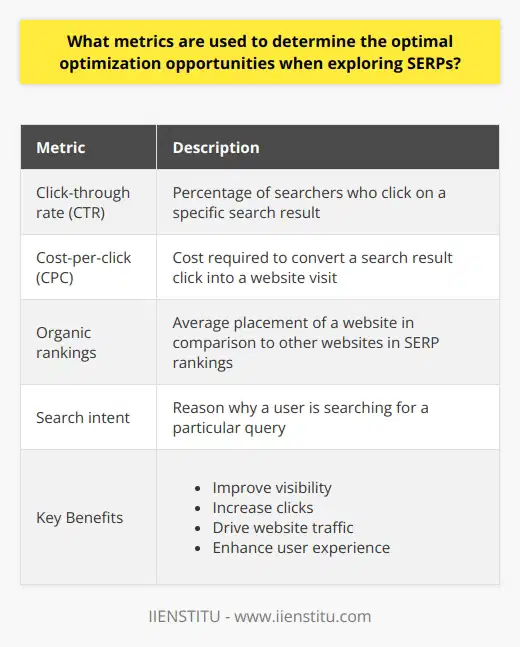
How can one ensure their SERPs optimization opportunities provide long-term success?
As we move into the digital marketing era, Search Engine Results Page (SERP) optimization is becoming increasingly important. As a result, businesses need to optimize their SERP opportunities to maximize visibility and ensure long-term success.
One of the most important aspects of SEO is relevant keyword usage. Relevant keywords can drive more traffic to a website and generate more leads and conversions. Through keyword research, businesses can strategically identify and use the most effective keywords throughout the website and its associated content. In addition, regular keyword usage analysis and optimization can improve the discoverability of a website using targeted, high-quality content.
Furthermore, website navigation must be optimized for search engines to index a website's content effectively. Easy-to-navigate, user-friendly websites offer users a great experience which can help to boost organic search rankings. Moreover, businesses should focus on growing their organic search rankings by building links to their websites. This can be achieved through link-building, guest blogging, and social media marketing. Link building is typically one of the most effective ways to boost a website's search engine ranking.
Furthermore, businesses should optimize their website content for their SERP opportunities. This includes providing useful information, relevant content, and up-to-date topics. Additionally, the website should be free of duplicate or low-quality content, as search engine algorithms are continuously updated to detect and remove low-quality content from SERPs.
Businesses should also be mindful of technical SEO, which includes optimizing elements such as page titles, meta tags, and image tags. Optimizing these elements can improve search engine visibility and enhance the user experience, subsequently improving the website's SEO ranking. Additionally, website speed and mobile optimization are essential for SERP success, as search engines prefer fast, mobile-friendly sites.
Lastly, SERP optimization is an ongoing process, and businesses must remain current with the latest SEO strategies and trends. Through regularly engaging in SERP optimization practices, companies can maximize their online visibility and ensure long-term search engine success.
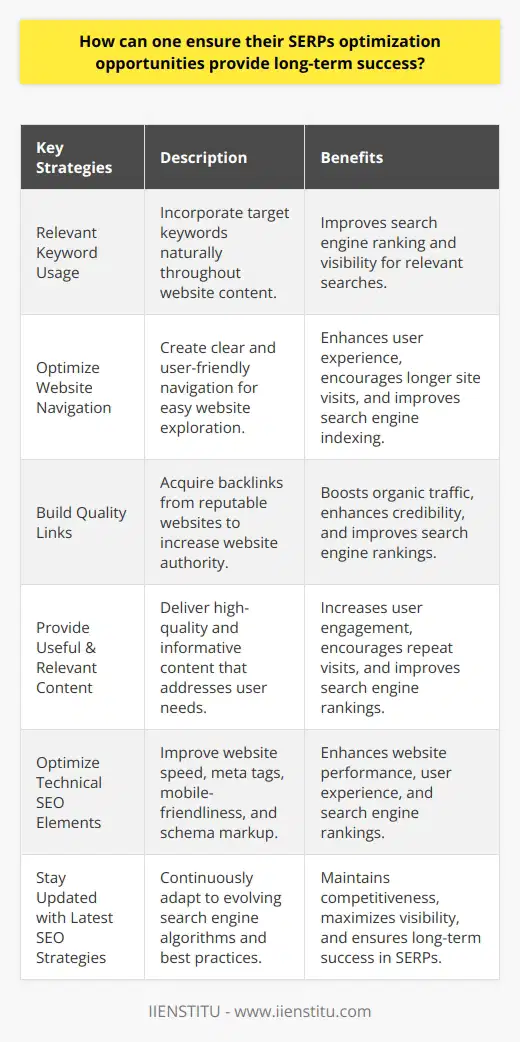
What strategies can be used to compare the SERPs optimization opportunities of different websites?
Search Engine Result Page (SERP) optimization is essential to web development and website success. It is the process of optimizing the positioning of a website within search engine results to improve its visibility and ranking. Since SERP optimization can be complex, it is essential to have strategies to compare different websites for SERP optimization opportunities.
One such strategy is analyzing the search engine visibility of a website. This can involve conducting a keyword analysis to identify the main keywords customers use to search for products or services similar to those offered by the website and researching the dominant SERPs for the chosen search terms. In addition, SEO audit tools such as Ahrefs and SEMrush can be used to measure the brand visibility of the website in the SERPs for competing keywords for the chosen topics. These insights can inform the development of an SEO strategy to target and improve SERP visibility.
Another strategy is to compare SERP features for different websites. Features such as rich snippets, featured snippets, and Maps listings can improve the visibility of a website in the SERPs, so it is essential to compare the different websites in terms of SERP features. In addition, tools such as Search Console and Moz can identify website performance in the SERPs and compare SERP features to identify optimization opportunities.
In addition, competitor website analysis can be a helpful strategy. Analyzing competitors' websites and their SERP visibility can inform SEO strategies and help identify SERP optimization opportunities. SEO tools such as Ahrefs, Moz, and SEMrush can provide insights on a competitor's SEO performance and visibility in the SERPs and generate keyword analytics and other insights.
Finally, an in-depth website content audit can also form part of a SERP optimization strategy. An audit can provide insights into the website's performance in the SERPs, including keyword optimization opportunities, page speed and loading issues, internal linking issues, and poor content optimization. It can also provide insights into how competitors are optimizing their content for the SERPs.
In conclusion, various strategies can be used to compare the SERP optimization opportunities of different websites. For example, analyzing search engine visibility, comparing SERP features, conducting competitor website analysis, and conducting an in-depth website audit can provide insights into SERP optimization opportunities. With careful execution of these strategies, website owners can develop successful SEO strategies and optimize their website's visibility in the SERPs.
